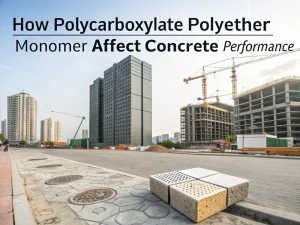Blog
Concrete admixtures are substances added to concrete during the mixing process (in small doses, typically 0.5-5% of the weight of cement), which solve challenges such as slow solidification in cold weather, overheating during curing, or poor workability of high-strength mixtures. Admixtures can be chemical (synthetic compounds) or mineral (natural or industrial byproducts), each tailored to specific needs.
Imagine concrete as a recipe for baking a cake. Cement, sand, stones, and water are the foundation of making cakes, flour, and eggs. And concrete admixtures are like “yeast”, “vanilla extract”, or “cocoa powder” in the formula. Although their dosage is not large, they are key components that give the final product special properties and improve quality.
In modern architecture, admixtures are no longer an option, but a necessity to ensure that concrete meets specific engineering needs.
Water reducing agents, especially their high-performance version – Superplasticizers, are the most important additives. It can significantly reduce the amount of water used in mixing while maintaining the fluidity (workability) of concrete. Alternatively, greatly increases the fluidity of concrete without changing the water usage.
Water reducing agent advantages:
Enhance Strength: Reduce water usage and directly lower the water-cement ratio, thereby significantly improving the final strength of concrete.
Improving workability: making concrete easier to pump, pour, and fill, especially suitable for structures with dense steel reinforcement.
Save cement: While maintaining the same strength, the amount of cement used can be correspondingly reduced by reducing the water consumption, thereby reducing costs.
Water reducing agent type:
Plasticizer: saving 5-15% water, very suitable for general buildings (slabs, beams), improving workability without sacrificing strength.
Superplasticizer: like polycarboxylate superplasticizer, it can reduces water by 25-40%, allowing high-strength concrete (such as bridges, skyscrapers) or self-compacting concrete (SCC) to flow without vibration.
The retarder slows down the setting time of concrete, which can slow down the hydration reaction rate of cement, thereby prolonging the setting time of concrete.
Retarder advantages:
Extended working hours: In hot weather, it can counteract the rapid condensation caused by high temperatures.
Avoid cold joints: When pouring large volumes or in stages, ensure good bonding between the new and old concrete layers.
Support long-distance transportation: Ensure that the concrete maintains good workability when it arrives at the construction site.
Retarder common applications:
Construction in hot climates, pouring of large volume concrete (such as dams, thick raft foundations), and long-distance transportation of commercial concrete.
Retarder types:
Carbohydrates, such as sodium gluconate; Lignin derivatives; Organic phosphonates.
Accelerator accelerates the solidification and early strength development of concrete, which is very useful in cold weather or when rapid removal of formwork is required. The effect is exactly opposite to that of a retarder.
Accelerator accelerates advantages:
Improve early strength: Especially effective at low temperatures, it can counteract the slow hydration reaction caused by low temperatures.
Shorten maintenance time: Accelerate construction progress and save time and costs.
Quick repair: suitable for concrete structure repair projects that need to be restored to use as soon as possible.
Accelerator accelerates common applications:
Construction in cold climates, production of precast concrete components, and emergency repair projects.
These admixtures will generate small and stable bubbles (accounting for 1-8% of the concrete volume), thereby improving the frost resistance and workability.
When the moisture in concrete freezes, its volume will expand by about 9%. These tiny bubbles provide a buffer space for the expansion of ice crystals, thereby preventing concrete from cracking and damage due to internal stress.
Air entrainer advantages:
Freeze-thaw resistance: greatly improves the ability of concrete to resist freeze-thaw cycle damage.
Improvement and workability: Micro bubbles act like rolling balls, improving the workability of freshly mixed concrete.
Reduce bleeding and segregation: make the concrete mixture more uniform and stable.
Air entrainer applications:
Structures exposed to freeze-thaw environments, such as road surfaces, bridge decks, airport runways, and dams in cold regions.
Air entrainer type:
Wood resin, synthetic detergent, alkylbenzene sulfonate.
Corrosion inhibiting admixtures can migrate to the surface of steel bars in concrete, forming a protective film that delays or prevents corrosion of steel bars due to chloride ion erosion and other reasons. This protects the steel bars in concrete from rusting and extends the life of the structure, which is crucial in harsh environments.
Corrosion inhibiting admixtures advantages:
Enhanced durability: greatly improves the service life of the structure in corrosive environments such as marine environments and areas using snowmelt salts.
Active protection: Provide active chemical protection for steel bars, not just physical barriers.
Corrosion inhibiting admixtures applications:
Concrete structures in corrosive environments such as ocean docks, cross-sea bridges, parking lots (especially in areas where snowmelt salts are used), chemical plants, etc.
Corrosion inhibiting admixtures type:
Calcium nitrite, amine, chromate.
Unlike chemical admixtures, mineral admixtures are finely ground materials that are typically used as partial substitutes for cement. They not only reduce costs and carbon emissions, but also significantly improve the later strength, durability, and chemical resistance of concrete.
Mineral admixtures types:
Fly ash: a byproduct of coal combustion that enhances and facilitates, reduces hydration heat (suitable for large volume concrete).
Fine ground blast furnace slag (GGBS): improves strength and chemical resistance (e.g., in sewage pipes).
Silicon powder: an ultrafine material that enhances strength and impermeability (used for high-performance concrete).
Concrete admixtures are the intelligent crystallization of modern engineering technology. Whether you need faster solidification, freeze-thaw resistance, or high strength, there is a mixture that can meet the challenges. By scientifically selecting and using one or more admixtures, engineers can customize concrete that meets any harsh environmental and performance requirements, much like a precise prescription formulation.

How Polycarboxylate Polyether Monomer Affect Concrete Performance
Blog How Polycarboxylate

How Polycarboxylate Superplasticizer Interacts With Slag In Concrete
Blog How Polycarboxylate